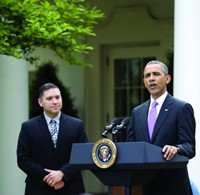Advertisement
Grab your lab coat. Let's get started
Welcome!
Welcome!
Create an account below to get 6 C&EN articles per month, receive newsletters and more - all free.
It seems this is your first time logging in online. Please enter the following information to continue.
As an ACS member you automatically get access to this site. All we need is few more details to create your reading experience.
Not you? Sign in with a different account.
Not you? Sign in with a different account.
ERROR 1
ERROR 1
ERROR 2
ERROR 2
ERROR 2
ERROR 2
ERROR 2
Password and Confirm password must match.
If you have an ACS member number, please enter it here so we can link this account to your membership. (optional)
ERROR 2
ACS values your privacy. By submitting your information, you are gaining access to C&EN and subscribing to our weekly newsletter. We use the information you provide to make your reading experience better, and we will never sell your data to third party members.
Education
Furlough Friday Science Days
University of Oregon hosts science outreach program for middle school students
by Linda Wang
April 22, 2013
| A version of this story appeared in
Volume 91, Issue 16

About once a month, usually on a Friday, students from Hamlin Middle School, in Springfield, Ore., don lab coats, safety glasses, and nitrile gloves and get to work setting up their chemistry experiments. This might seem like an ordinary chemistry lab, except that these students are not at Hamlin Middle School, and this is no typical school day.
Instead, these middle school students are at the University of Oregon, thanks to an outreach program started by the university during the 2011–12 school year to provide hands-on science activities for middle school students on days that their teachers have been furloughed.
Because of statewide budget cuts, public schools across Oregon have implemented teacher furloughs, according to Michelle Jensen, project director of the 21st Century Community Learning Centers after-school programs in Springfield Public Schools. She notes that during the 2012–13 school year, Hamlin Middle School cut a total of eight school days because of these furloughs.
“I think it’s a travesty,” says Shannon W. Boettcher, an assistant professor of chemistry at the University of Oregon who helped create the Furlough Friday Science Days outreach program. “Public education is the best investment that we could ever make, especially in the sciences.”
“We created the outreach program because we saw a need for increased science education due to state budget cuts,” says Michael D. Pluth, an assistant professor of chemistry at the University of Oregon and cocreator of the program. “The great thing about science education is that it’s hands-on. If students are not experiencing that, I don’t think they get a good feel for what the scientific process is.” The program is supported by a three-year, $25,000 grant from the Camille & Henry Dreyfus Special Grant Program in the Chemical Sciences.
In the first year of the outreach program, roughly 50 students from Hamlin Middle School participated in 10 outreach days at the University of Oregon.
Activities have covered topics such as solar energy, the chemistry of color, and acid-base chemistry. In a lab on electrochemistry and batteries, for example, students constructed and optimized Zn-, Cu-, and Fe-based galvanic cells using saltwater, Gatorade, lemons, pickles, and potatoes as electrolytes. The students then measured and recorded current and voltage produced by the different cells and competed to design the best battery based on what they learned.
Pluth says he and his colleagues from the outreach program chose Hamlin Middle School as its pilot school because a majority of its students are from families who are living below the poverty line.
Paul Griffith, after-school program coordinator for Hamlin Middle School, says that the extra instruction time is invaluable. The furlough days mean instruction time is lost, he says, “and this program is providing an opportunity for up 25 students to continue learning.”
Cynthia Nagao, whose foster son participates in the Furlough Fridays program, credits the outreach program with helping to plant the seeds of college in her foster son’s mind. Before her foster son started attending the Furlough Fridays program, Nagao says, he didn’t see himself going to college but could see himself going to prison. “After five or six months, there was a very clear turning point for this child where his conversations started being more about, ‘When I go to college,’ ” Nagao says. “Somewhere, there was a shift in his thinking, and part of it is because he got to spend some time on a college campus.”
Pluth attributes the program’s success to a mentoring chain where high school students taking Advanced Placement chemistry, overseen by chemistry graduate students at the university, guide the middle school students. “Hopefully, some of the middle school kids, when they move on to high school, will come back and volunteer as mentors for new middle school students,” making the program sustainable, Pluth says.
He hopes to expand the program to allow more students from more schools to participate, but he acknowledges that they can only do so much. “This is a Band-Aid,” he says; the real solution is better support for education.
Nevertheless, building relationships between colleges, high schools, and middle schools is a worthwhile investment, says Boettcher. “Even if the schools were funded really well, drawing a connection from the university to middle school and showing students this path, that’s what we as practicing scientists can help with,” he says.





Join the conversation
Contact the reporter
Submit a Letter to the Editor for publication
Engage with us on Twitter